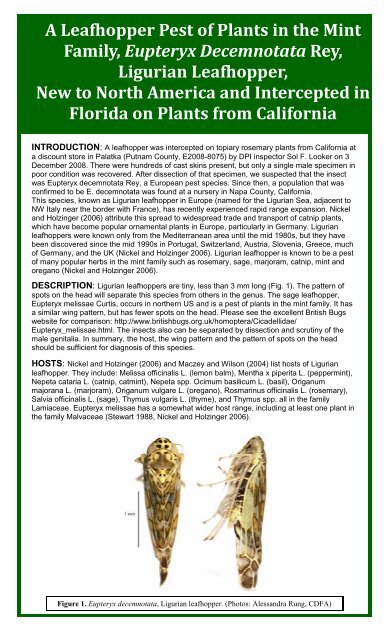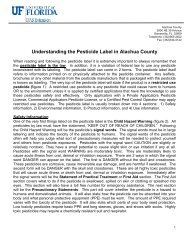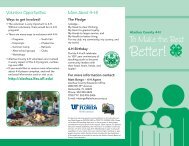June-A Leafhopper Pest of Plants in the Mint Family.pub
June-A Leafhopper Pest of Plants in the Mint Family.pub
June-A Leafhopper Pest of Plants in the Mint Family.pub
Create successful ePaper yourself
Turn your PDF publications into a flip-book with our unique Google optimized e-Paper software.
A <strong>Leafhopper</strong> <strong>Pest</strong> <strong>of</strong> <strong>Plants</strong> <strong>in</strong> <strong>the</strong> M<strong>in</strong>t<br />
<strong>Family</strong>, Eupteryx Decemnotata Rey,<br />
Ligurian <strong>Leafhopper</strong>,<br />
New to North America and Intercepted <strong>in</strong><br />
Florida on <strong>Plants</strong> from California<br />
INTRODUCTION: A leafhopper was <strong>in</strong>tercepted on topiary rosemary plants from California at<br />
a discount store <strong>in</strong> Palatka (Putnam County, E2008-8075) by DPI <strong>in</strong>spector Sol F. Looker on 3<br />
December 2008. There were hundreds <strong>of</strong> cast sk<strong>in</strong>s present, but only a s<strong>in</strong>gle male specimen <strong>in</strong><br />
poor condition was recovered. After dissection <strong>of</strong> that specimen, we suspected that <strong>the</strong> <strong>in</strong>sect<br />
was Eupteryx decemnotata Rey, a European pest species. S<strong>in</strong>ce <strong>the</strong>n, a population that was<br />
confirmed to be E. decemnotata was found at a nursery <strong>in</strong> Napa County, California.<br />
This species, known as Ligurian leafhopper <strong>in</strong> Europe (named for <strong>the</strong> Ligurian Sea, adjacent to<br />
NW Italy near <strong>the</strong> border with France), has recently experienced rapid range expansion. Nickel<br />
and Holz<strong>in</strong>ger (2006) attribute this spread to widespread trade and transport <strong>of</strong> catnip plants,<br />
which have become popular ornamental plants <strong>in</strong> Europe, particularly <strong>in</strong> Germany. Ligurian<br />
leafhoppers were known only from <strong>the</strong> Mediterranean area until <strong>the</strong> mid 1980s, but <strong>the</strong>y have<br />
been discovered s<strong>in</strong>ce <strong>the</strong> mid 1990s <strong>in</strong> Portugal, Switzerland, Austria, Slovenia, Greece, much<br />
<strong>of</strong> Germany, and <strong>the</strong> UK (Nickel and Holz<strong>in</strong>ger 2006). Ligurian leafhopper is known to be a pest<br />
<strong>of</strong> many popular herbs <strong>in</strong> <strong>the</strong> m<strong>in</strong>t family such as rosemary, sage, marjoram, catnip, m<strong>in</strong>t and<br />
oregano (Nickel and Holz<strong>in</strong>ger 2006).<br />
DESCRIPTION: Ligurian leafhoppers are t<strong>in</strong>y, less than 3 mm long (Fig. 1). The pattern <strong>of</strong><br />
spots on <strong>the</strong> head will separate this species from o<strong>the</strong>rs <strong>in</strong> <strong>the</strong> genus. The sage leafhopper,<br />
Eupteryx melissae Curtis, occurs <strong>in</strong> nor<strong>the</strong>rn US and is a pest <strong>of</strong> plants <strong>in</strong> <strong>the</strong> m<strong>in</strong>t family. It has<br />
a similar w<strong>in</strong>g pattern, but has fewer spots on <strong>the</strong> head. Please see <strong>the</strong> excellent British Bugs<br />
website for comparison: http://www.britishbugs.org.uk/homoptera/Cicadellidae/<br />
Eupteryx_melissae.html. The <strong>in</strong>sects also can be separated by dissection and scrut<strong>in</strong>y <strong>of</strong> <strong>the</strong><br />
male genitalia. In summary, <strong>the</strong> host, <strong>the</strong> w<strong>in</strong>g pattern and <strong>the</strong> pattern <strong>of</strong> spots on <strong>the</strong> head<br />
should be sufficient for diagnosis <strong>of</strong> this species.<br />
HOSTS: Nickel and Holz<strong>in</strong>ger (2006) and Maczey and Wilson (2004) list hosts <strong>of</strong> Ligurian<br />
leafhopper. They <strong>in</strong>clude: Melissa <strong>of</strong>fic<strong>in</strong>alis L. (lemon balm), Mentha x piperita L. (pepperm<strong>in</strong>t),<br />
Nepeta cataria L. (catnip, catm<strong>in</strong>t), Nepeta spp. Ocimum basilicum L. (basil), Origanum<br />
majorana L. (marjoram), Origanum vulgare L. (oregano), Rosmar<strong>in</strong>us <strong>of</strong>fic<strong>in</strong>alis L. (rosemary),<br />
Salvia <strong>of</strong>fic<strong>in</strong>alis L. (sage), Thymus vulgaris L. (thyme), and Thymus spp. all <strong>in</strong> <strong>the</strong> family<br />
Lamiaceae. Eupteryx melissae has a somewhat wider host range, <strong>in</strong>clud<strong>in</strong>g at least one plant <strong>in</strong><br />
<strong>the</strong> family Malvaceae (Stewart 1988, Nickel and Holz<strong>in</strong>ger 2006).<br />
Figure 1. Eupteryx decemnotata, Ligurian leafhopper. (Photos: Alessandra Rung, CDFA)
Damage and Economic Importance: These leafhoppers are mesophyll<br />
feeders. They puncture cells and remove <strong>the</strong> contents, leav<strong>in</strong>g air to fill <strong>the</strong> void. This<br />
produces <strong>the</strong> characteristic stippl<strong>in</strong>g produced by <strong>the</strong>se and similar leafhoppers <strong>in</strong> <strong>the</strong><br />
subfamily Typhlocyb<strong>in</strong>ae. A well-known example <strong>of</strong> a leafhopper that causes similar<br />
feed<strong>in</strong>g damage is <strong>the</strong> potato leafhopper, Empoasca fabae. The damage can be<br />
mistaken for thrips, lacebug or mite <strong>in</strong>jury. In Europe, populations can be high, caus<strong>in</strong>g<br />
significant damage to <strong>the</strong> plants. Our Florida sample <strong>in</strong>cluded hundreds <strong>of</strong> cast sk<strong>in</strong>s,<br />
<strong>in</strong>dicat<strong>in</strong>g that <strong>the</strong> population was very high at one time. Severe damage to cultivated<br />
plants by this species was reported <strong>in</strong> Switzerland, Greece and Germany (Nickel and<br />
Holz<strong>in</strong>ger 2006).<br />
FLORIDA DISTRIBUTION: So far, we have only one collection <strong>of</strong> <strong>the</strong> Ligurian<br />
leafhopper <strong>in</strong> Florida, <strong>the</strong> f<strong>in</strong>d at <strong>the</strong> discount store <strong>in</strong> Putnam County. However, we<br />
have anecdotal reports <strong>of</strong> similar damage to shipments <strong>of</strong> rosemary topiaries <strong>in</strong><br />
discount stores <strong>in</strong> o<strong>the</strong>r counties. It is possible that <strong>the</strong> leafhoppers may have found<br />
o<strong>the</strong>r related plants to feed on <strong>in</strong> some stores. Thus, <strong>in</strong>spections <strong>of</strong> potted kitchen<br />
herbs and m<strong>in</strong>t-related bedd<strong>in</strong>g plants for sale <strong>in</strong> discount stores and supermarkets<br />
would be advised.







